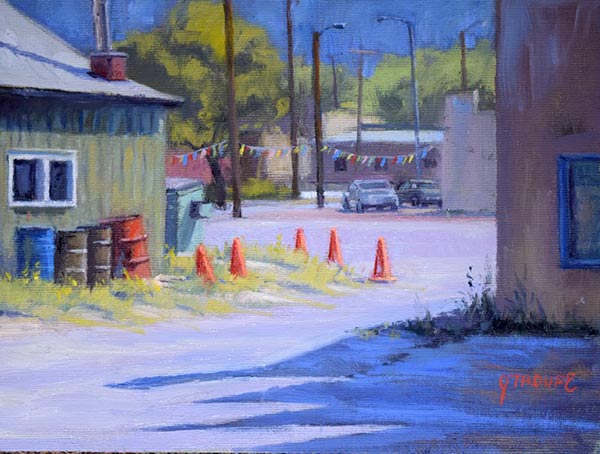– Bob Bahr reporting, Editor PleinAir Today –
Jeff Troupe’s painting “Behind the Lot” caught our eye, and when we asked the Montana artist to talk a little bit about its judicious use of bold color, Troupe had some valuable comments.
Lead Image: “Behind the Lot,” by Jeff Troupe, 2016, oil, 6 x 8 in.
First, Troupe found a parallel in music. “Color in painting and musical notes in musical composition have many correlations,” says the artist. “I enjoy using bold color in my paintings, which I learned from instructors such as Brian Blood and Randall Sexton, who use bold colors in their work. But if all the colors in a work are bold, color loses its impact; it can be overwhelming, just like in music if all the notes are intense, you would be left with something that could be quite repetitive.”
“In ‘Behind the Lot’ I used orange cones as intense color accents that focus the viewer’s attention. They are all the more effective as they exist in a largely neutral/purple setting. Other colorful elements, such as the multi-colored streamers or the green dumpster, serve in supporting roles to the main attraction or focal point. These supporting elements create a more complex and dynamic composition that is sometimes intense, sometimes quiet, sometimes calm, sometimes loud — just like in a well-composed musical composition with a variety of types of notes, which often build to a climax to have a bigger emotional impact.”
Although these spots of vibrant color seem to propel Troupe’s painting, he points out that there are other ways to use it. “Bold color doesn’t always have to be the focal point of a work,” Troupe says. “Sometimes it can be a strong value contrast or a complex shape surrounded by simple shapes. I do enjoy using it, though, and urban scenes often lend themselves to this use of color, as natural elements are often more neutral in color.”
Troupe goes on, “I think one of my big attractions to urban scenes is the opportunity to use bold color. The geometric shapes and harder edges are fun problems to tackle, and a nice change of pace from painting in Glacier National Park, where the subject matter is mostly natural. Kalispell, Montana, where I live, is a small town, so skyscrapers and vast public spaces like you would find in a larger city are not here. So the urban scenes are not quite as obvious in that you have to go hunting for little gems like this one, which could be easily overlooked by most. I think there is something valid about capturing small-town America on canvas, and I think it is something many people living in the cities long for. I know I certainly did, which is a big part of why I made the move out here with my family almost two years ago from California.”




